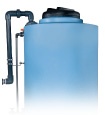Sulfuric acid (H2SO4) is an NSF/ANSI 60 approved chemical at a 98% concentration or less. Poly Processing’s tank systems are NSF/ANSI/CAN 61 approved to store Sulfuric acid at 98% concentration or less. Sulfuric acid is a highly corrosive mineral acid that challenges traditional storage options. This pungent, colorless to slightly yellow viscous liquid is occasionally dyed dark brown during production to alert people to its hazards. The biggest challenges in working with sulfuric acid are that it is an aggressive oxidizer and it is very heavy. These challenges threaten the strength and design of many storage tanks. Poly Processing’s tanks and fittings can be combined specifically to store sulfuric acid and reduce the risks. Let’s take a closer look at what sulfuric acid is, how it’s used, and how you can overcome its corrosive challenge with the right storage tanks.
Topics:
Chemicals
When it comes to storage solutions for liquids, high density crosslinked polyethylene (XLPE) storage tanks are an excellent choice due to their durability, corrosion resistance, versatility and useful life. If you're considering investing in an XLPE storage tank, it’s crucial to understand the complete journey from ownership to retirement.
Topics:
News and Customer Stories,
Tank Design and Materials
Certain chemicals — such as ferric, alum, and hydrochloric acid — can be inherently higher temperature chemicals. To avert catastrophic failure of your chemical storage tank, a margin of safety is required to manage risk.
Topics:
Fittings and Accessories
Although it's impossible to know what the exact lifespan of your polyethylene tank will be, there are steps you can take to extend its life in order to get the most out of it.
Topics:
News and Customer Stories,
Tank Design and Materials
Poly Processing manufactures a wide variety of storage tank systems that are compatible with many different chemicals, including fuming chemicals that must be securely sealed when stored. For these chemical applications, the use of a fume-tight lid is usually required. Let’s take a closer look at how a fume-tight lid functions, when a fume-tight lid might be required, and what options are available to meet your chemical storage needs.
Topics:
Venting,
Fittings and Accessories
Maintaining the proper temperature of a chemical inside a high density crosslinked polyethylene tank can be critical for safe and effective storage. For example, sodium hydroxide and caustic soda need to maintain temperature to prevent crystallization at lower temperatures.
Topics:
News and Customer Stories,
Tank Design and Materials
Storage tank accessories and fittings are often seen as extra add-ons that get little consideration — as if they were nice-to-have features like heated seats in a new vehicle. However, these are critical components of a successful storage system. The useful life of your chemical storage tank can be greatly impacted by your choice of fittings and accessories.
Topics:
News and Customer Stories,
Tank Design and Materials
On January 9, 2014, a chemical spill fouled the water supply for thousands of West Virginians in the U.S. A hazardous chemical used for washing coal called 4-methylcyclohexane methanol, or “crude MCHM,” leaked from an industrial facility into the Elk River near Charleston, West Virginia. The incident could have been prevented if a proper secondary containment system had been in place.
Topics:
Fittings and Accessories
Proper venting of a chemical storage tank system helps ensure safe operation and can also extend the useful life of the cross-linked polyethylene (XLPE) tank. Poly Processing Company sees venting as one of the most critical parts of a safe chemical storage system. We also attach venting labels to tanks manufactured at our facilities to emphasize the critical importance of proper venting.
Topics:
Venting
This article is part 2 of a two-article series that provides an overview of some important industry and regulatory compliance issues you should be aware of when purchasing a chemical storage tank. Read the first article of this series to learn about ASTM and NSF/ANSI/CAN 61 standards.
Topics:
News and Customer Stories,
Tank Design and Materials



